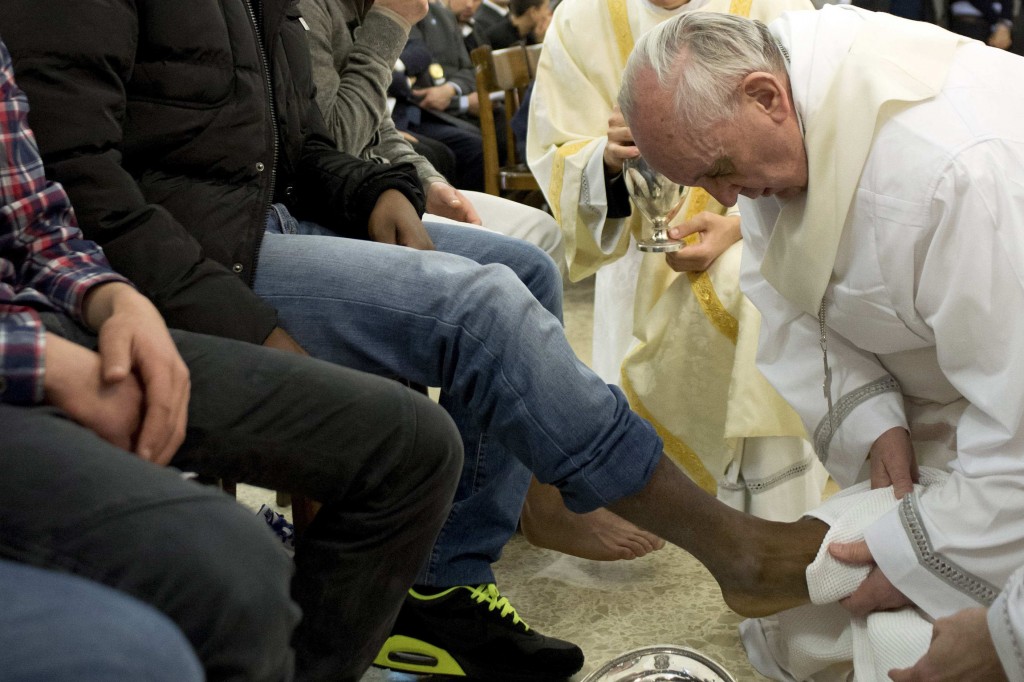The Pope today celebrated the Holy Thursday Mass of the Lord's Supper in a juvenile prison, where he washed the feet of 12 young people. Two of them were young women. Two were Muslims. The question of whether or not women's feet may be washed has been a contentious one in recent years. At issue is the question of what the foot washing on Holy Thursday represents: humble service (something to be practiced by all disciples), or the founding of the ministerial priesthood. The latter notion seems to be a deduction: 12 men were indicated in the rubrics of the 1955 text, which suggests a role-play of the Last Supper.
The 1988 Circular Letter from the Vatican Congregation for Divine Worship, Paschale Solemnitatis, "On Preparing and Celebrating the Paschal Feasts," although keeping to the letter of the 1955 rubric men weighs in firmly on the side of service. It says that The washing of feet represents the service and charity of Christ, who came not to be served, but to serve. This tradition should be maintained and its proper significance explained. (no. 51). The rite generally has been interpreted as one of charity and humble service, rather than sacerdotal institution, by parish communities in the United States. As the Church has traveled from the 1950s to the present, the favored way to celebrate this rite has been with both men and women participating. The note on this subject on the USCCB website confirms that the inclusion of women had become customary in the U.S. by the mid-eighties, when the question arose about restricting the gesture to males only. The rubrics today in the Third Edition of the Roman Missal say that men (males) selected for this rite (viri selecti -- the number 12 has been dropped) are led forward. That's all.
How much importance is placed on that single word in the rubrics (viri) varies. The foot washing itself is not required by the rubrics. The optional quality of this practice was a result of disagreement about whether the action itself would be accessible in modern cultures. Sadly, some have dropped it in recent years precisely because they would prefer not to do it at all than to offend women by excluding them.
Although foot washing traditions in cathedrals, in monasteries, etc. have a long history, the rubric for washing feet in the Evening Mass of the Lord's Supper dates from the 1955 revision of the Holy Week rites, undertaken under Pius XII. Peter Jeffrey details the origins of this rite in his book, A New Commandment: Toward a Renewed Rite for the Washing of Feet (Collegeville: Order of St. Benedict, 1985). He concludes that the practice on Holy Thursday today ought to be taken as one of charity, and that it belongs to the greater living tradition of foot washing in the Church -- a tradition which includes women.
Pope Francis would seem to agree. Hearing the news confirmed that the Pope washed female feet has sent some commenters on traditionalist blogs into a tailspin.Those US bishops who have issued guidelines forbidding the washing of women's feet on Holy Thursday may wish to review their policy in light of Pope Francis's example. But for the most part, Pope Francis's actions will seem genuinely good and appropriate to most Catholics. Many comments over the past few days have shown positive interest and deep approval of the Pope's decision. What I found most touching of all, however, was this response from incarcerated young people in Los Angeles County, California. They wrote letters to him. Here is one:
Dear Pope Francis,
Thank you for washing the feet of youth like us in Italy. We also are young and made mistakes. Society has given up on us, thank you that you have not given up on us.
Maybe women should write letters to him too.
UPDATE: You can see video clips of the liturgy here. Watch for the Pope's smile as he looks up at the teen whose feet he has just washed.


